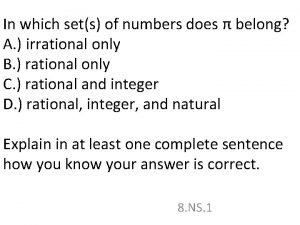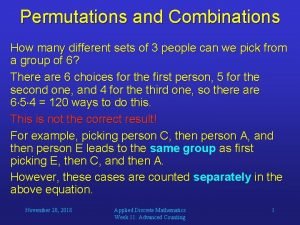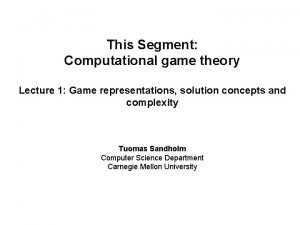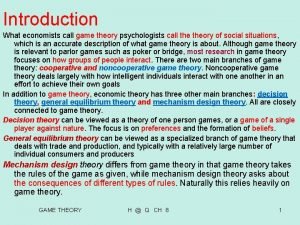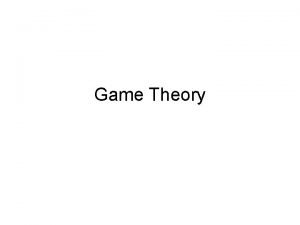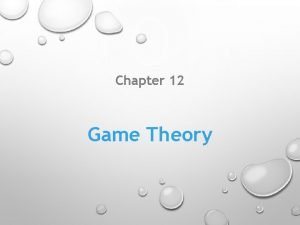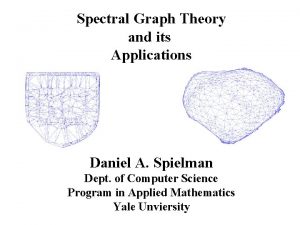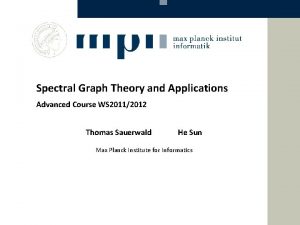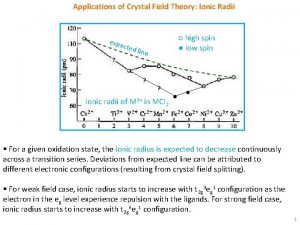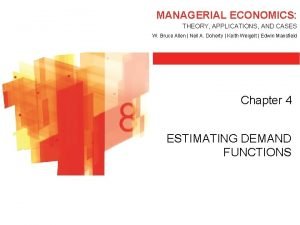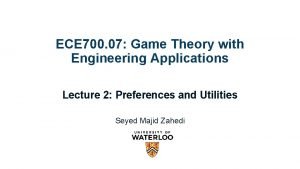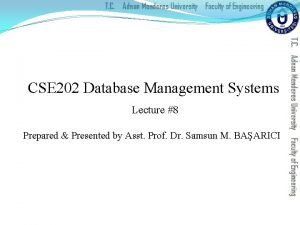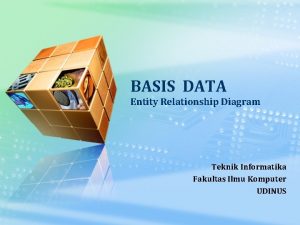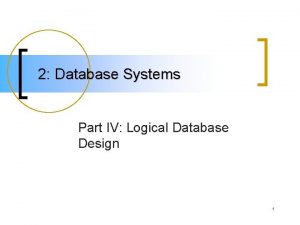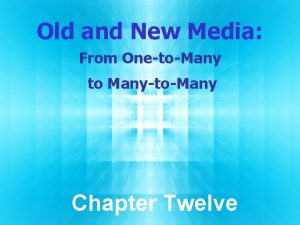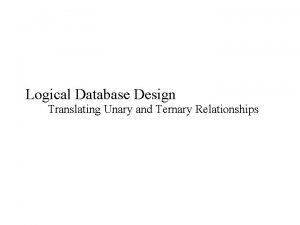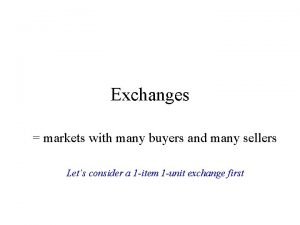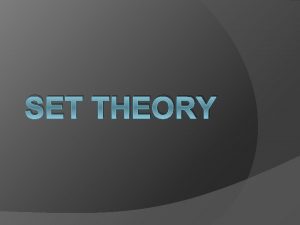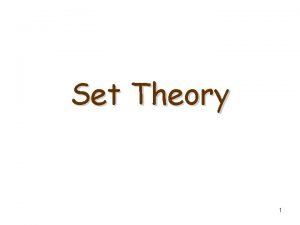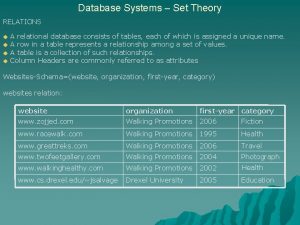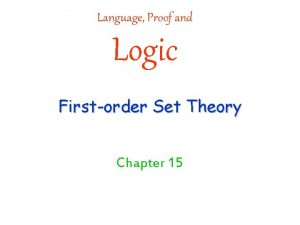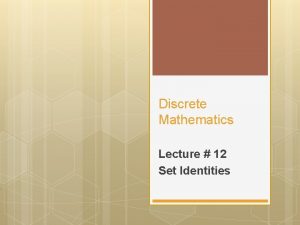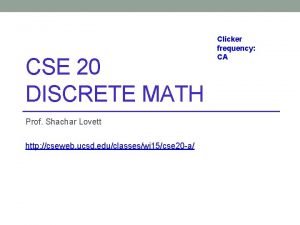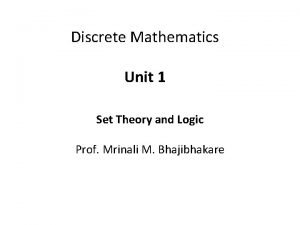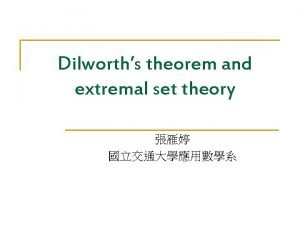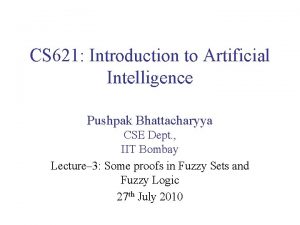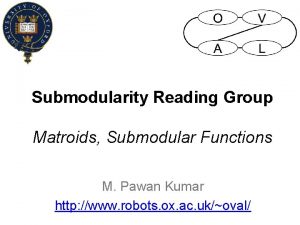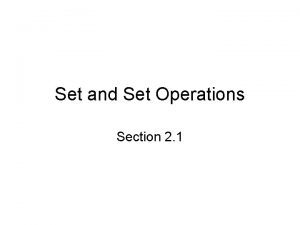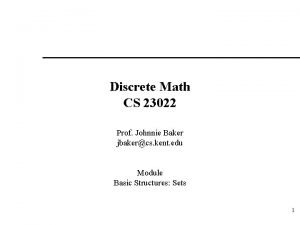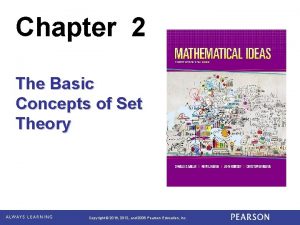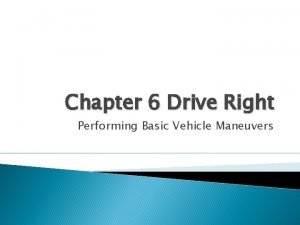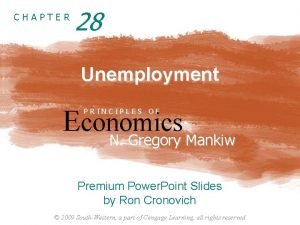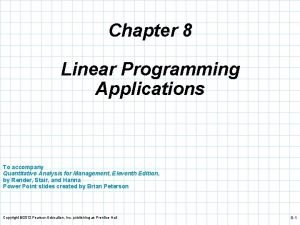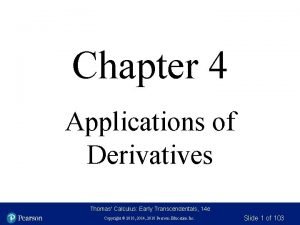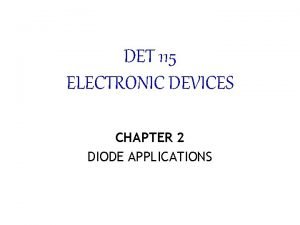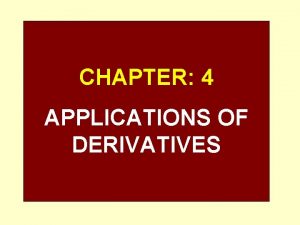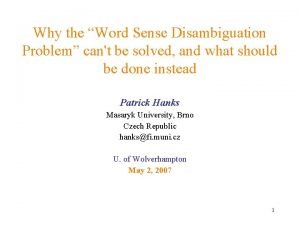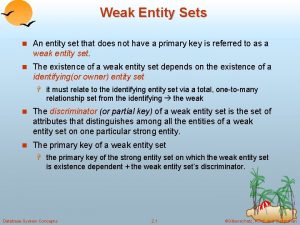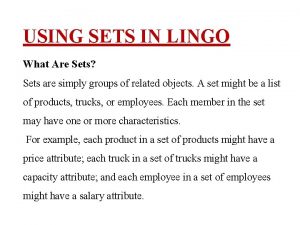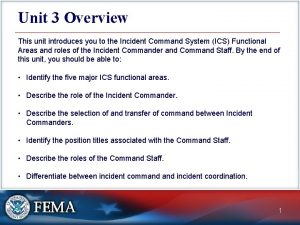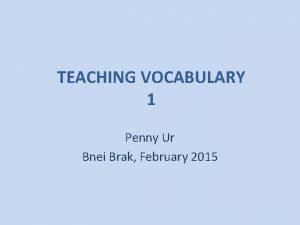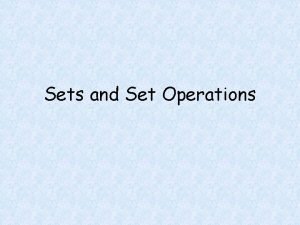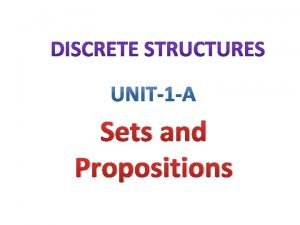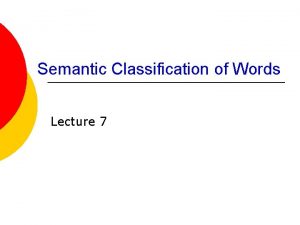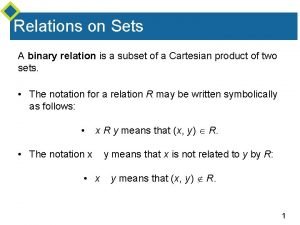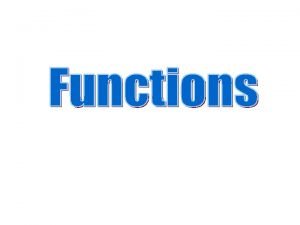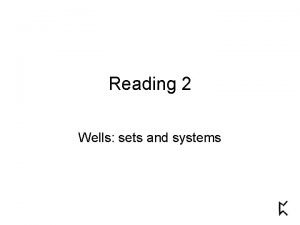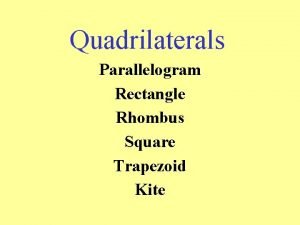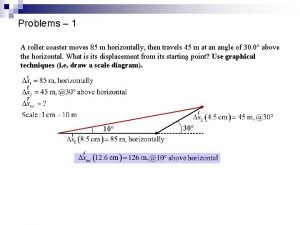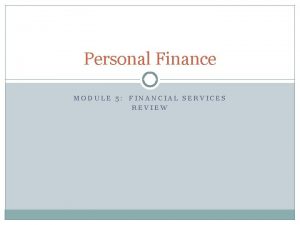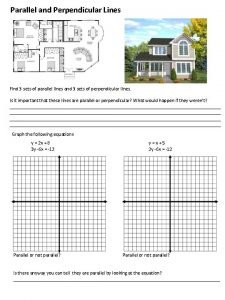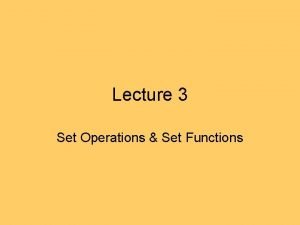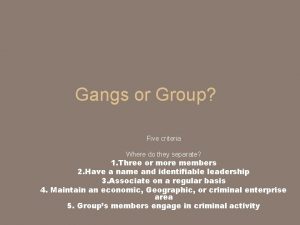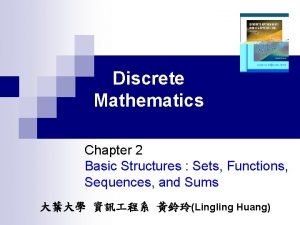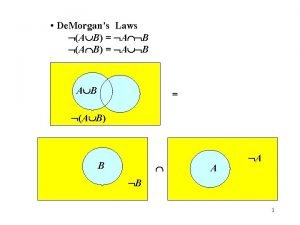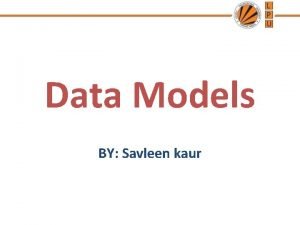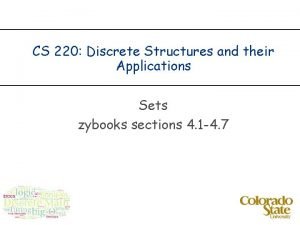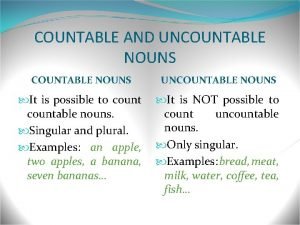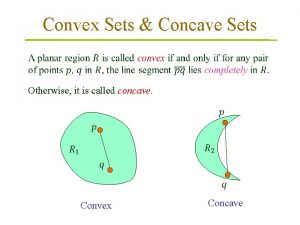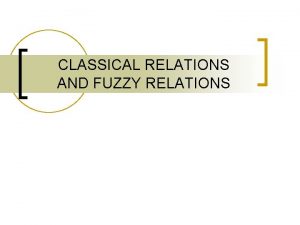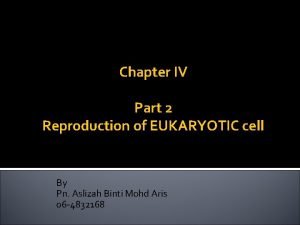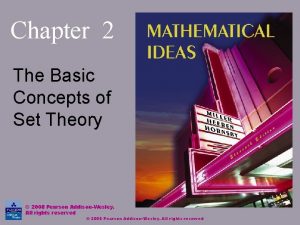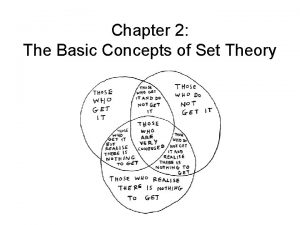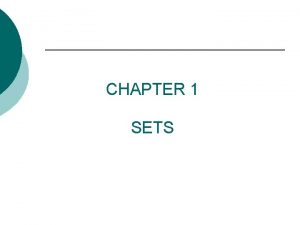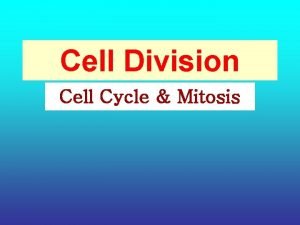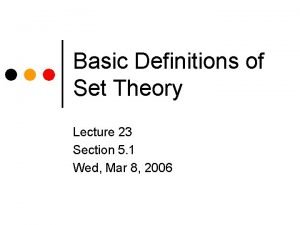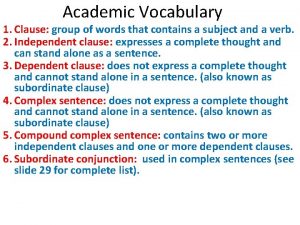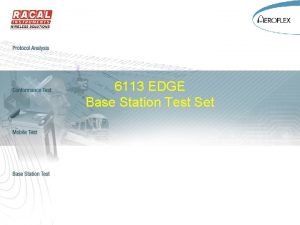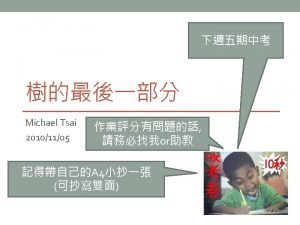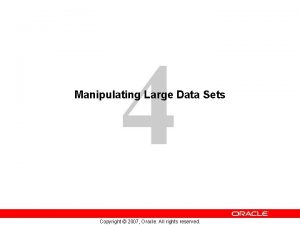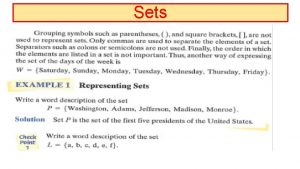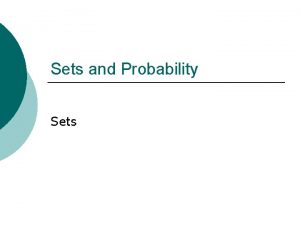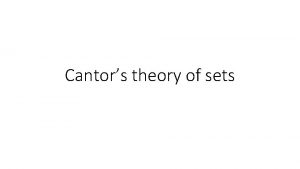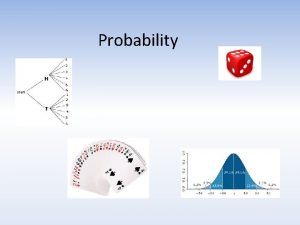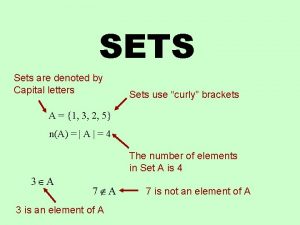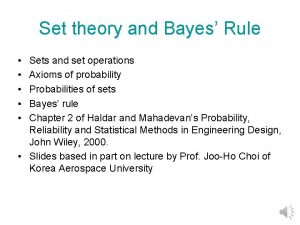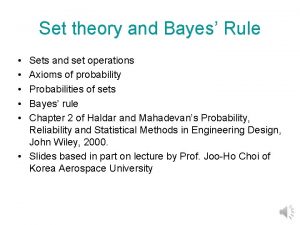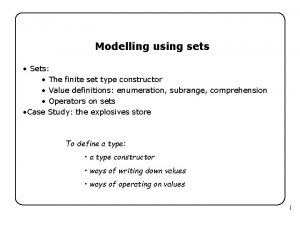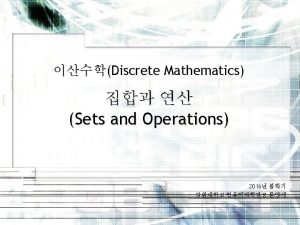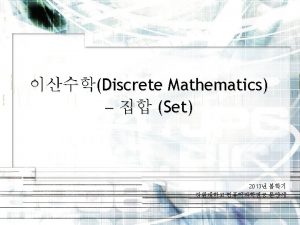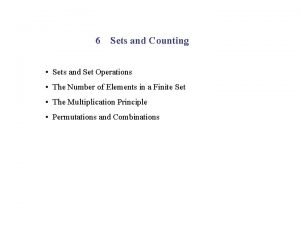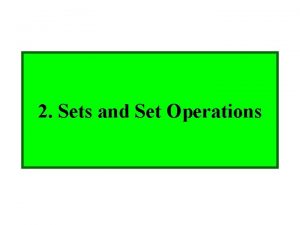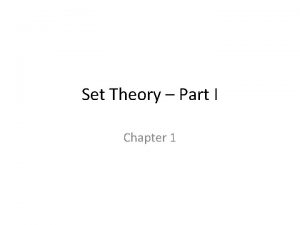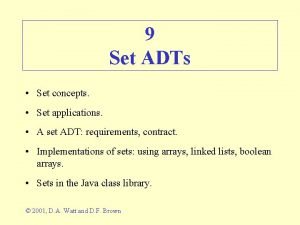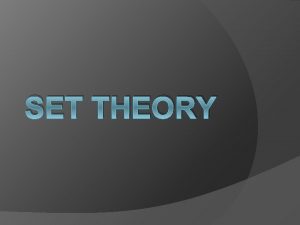Set Theory Chapter 3 Sets in applications Many








![Interval Notation [ a , b ] = { x | a ≤ x Interval Notation [ a , b ] = { x | a ≤ x](https://slidetodoc.com/presentation_image_h/1ff4da225872dc0be1c34f5dd6aba356/image-9.jpg)
























































































- Slides: 97

Set Theory Chapter 3

Sets in applications • Many pieces of software need to maintain sets of items. For example, a database is a large set of pieces of information. • A university maintains a set of all the students enrolled. • An airline maintains a set of all past and future flights. • One of the most basic types of operations a programmer might perform on a set of data is to ask whether a particular item is an element of that set. • Discrete math is primarily concerned with mathematical operations on sets.

Sets (3. 1) • A set is an unordered collection of objects. – the students in this class – the chairs in this room • The objects in a set are called the elements, items or members of the set. – A set is said to contain its elements.

Sets • The notation a ∈ A denotes that a is an element of the set A. • If a is not a member of A, write a ∉ A

Describing a Set: Roster Method • S = {a, b, c, d} • Order not important S = {a, b, c, d} = {b, c, a, d}

Describing a Set: Roster Method • Elipses (…) may be used to describe a set without listing all of the members when the pattern is clear. S = {a, b, c, d, ……, z }

Roster Method • Set of all vowels in the English alphabet: V = {a, e, i, o, u} • Set of all odd positive integers less than 10: O = {1, 3, 5, 7, 9} • Set of all positive integers less than 100: S = {1, 2, 3, ……. . , 99} • Set of all integers less than 0: S = {…. , -3, -2, -1}

Some Important Sets N = natural numbers = {0, 1, 2, 3…. } Z = integers = {…, -3, -2, -1, 0, 1, 2, 3, …} Z⁺ = positive integers = {1, 2, 3, …. . } = {x ε Z | x > 0} Q = set of rational numbers Q+ = set of positive rational numbers R = set of real numbers Φ, {} = empty set (null set)
![Interval Notation a b x a x Interval Notation [ a , b ] = { x | a ≤ x](https://slidetodoc.com/presentation_image_h/1ff4da225872dc0be1c34f5dd6aba356/image-9.jpg)
Interval Notation [ a , b ] = { x | a ≤ x ≤ b } [ a , b ) = { x | a ≤ x < b } ( a , b ] = { x | a < x ≤ b } ( a , b ) = { x | a < x < b } closed interval [a, b] open interval (a, b)

Representation of a set • A set-builder notation is used to describe sets that are too complex to enumerate them. – Suppose E={…. , -6, -4, -2, 0, 2, 4, 6, …. } – Set-builder notation E={n : n is an even integer} or E={n | n is an even integer} – Other examples A = {x : x is an integer |x| < 4} = {-3, -2, -1, 0, 1, 2, 3} – The rational numbers: Q={x : x = m/n, m, n Z, n ≠ 0}

Some illustrations of set-builder notation

Conceptually: • Conceptually, a set is like a bag containing objects. This bag can contain another bag containing other objects. • Example: A= {1, {1}, {2}, {1, 2}} – How many elements are in A? – 1 A? 2 A? {2} A? {{2}} A?

Universal set • The set containing all the elements mentioned in a particular context. – Set of real numbers – Set of rational numbers – Usually denoted by U

Venn diagrams • Sets are often represented pictorially with Venn diagram. • A rectangle is used to denote the universal set. • Oval shapes are usually used to denote sets within U.

Venn Diagram • It is often used to visualize the various relations between the sets.

Venn diagrams

Set of sets (3. 2) • The set A = {{1, 2}, Φ, {1, 2, 3}, {1}} has four elements: {1, 2}, Φ, {1, 2, 3}, {1}}. • The empty set Φ is not the same as Φ. • The cardinality of {Φ} is one.

Set of sets

Power set • Given a set A, the power set of A, P(A), is the set of all subsets of A. • Examples – Let A={a, b, c}, P(A)={ , {a}, {b}, {c}, {a, b}, {b, c}, {a, b, c}} – Let A={{a, b}, c}, P(A)={ , {{a, b}}, {c}, {{a, b}, c}} • Note: the empty set and the set itself are always elements of the power set.

Power set • The power set is a fundamental combinatorial object useful when considering all possible combinations of elements of a set • Fact: Let S be a set such that |S|=n, then |P(S)| = 2 n – Some intuition?

Power set • For B={1, 2, 3, 4}

Cardinality of a set • Cardinality of a set A, denoted by |A|: – – It is the number of elements in the set A set with finite number of elements is called a finite set. A set with infinite number of elements is called an infinite set. Sets N, Z, Q, R are all infinite. • Empty set has no element, denoted by – How many elements does the set { } contain?

Cardinality of a set • Cardinality of a set A, denoted by |A|: – – It is the number of elements in the set A set with finite number of elements is called a finite set. A set with infinite number of elements is called an infinite set. Sets N, Z, Q, R are all infinite. • Empty set has no element, denoted by – How many elements does the set { } contain? One

Equality of Sets, Subsets • If B is a subset of A, every element of B is an element of A. We write B A. • Two sets are equal if they have the same elements. • To show that two sets are equal, it is sufficient to show separately that – A B and – B A

Equality of Sets, Subsets (contd. ) Z+ is N, the set of natural numbers Q+ is the set of all positive rational numbers

Subsets (contd. ) • A set B is a proper subset of a set A, if it is a subset A and is not equal to A ( ). • If A is a subset of B and B is a subset of C, A is a subset of C. (Transitive relation) • Note that if A has at least one element, is a proper subset of A.

Set of sets • Let X={1, {1}, {1. 2}, 2, {3}, 4}. Which statements are true? – 2 ∈ X – {2} ∈ X – 3∈X – {1, 2} ∈ X – {1, 2} ⊆ X – {2, 4} ⊆ X – {2, 3} ⊆ X

Section 3. 3 • Set Operations – Union – Intersection – Complementation – Difference

Union • Definition: Let A and B be sets. The union of the sets A and B, denoted by A ∪ B, is the set: • Example: What is {1, 2, 3} ∪ {3, 4, 5}? Solution: {1, 2, 3, 4, 5} Venn Diagram for A ∪ B U A B

Operations on Sets Let A and B be two arbitrary sets. Let U be the universal set, (i. e. A U and B U). Union: A B = {x: x A or x B} Intersection: A B = {x: x A and x B} Difference: A – B = { x: x A and x B} Symmetric Difference: A △ B = {x: (x A and x B) or (x A and x B)} = (A – B) (B – A) • Complement: U – A = {x : x A} • •

Review Question Example: U = {0, 1, 2, 3, 4, 5, 6, 7, 8, 9, 10} A = {1, 2, 3, 4, 5}, B ={4, 5, 6, 7, 8} 1. A ∪ B Solution: {1, 2, 3, 4, 5, 6, 7, 8} 2. A ∩ B Solution: {4, 5} 3. Ā Solution: {0, 6, 7, 8, 9, 10} 4. Solution: {0, 1, 2, 3, 9, 10} 5. A – B Solution: {1, 2, 3} 6. B – A Solution: {6, 7, 8}

Operations on Sets

Operations on Sets A={(x, x 2) : x R} B={(x, ax + b) : x R and a, b R} R R R

Operations on Sets R R

Special notation • Intersection and union of a long sequence of sets A 1, A 2, . . . , An.

Exercise 3. 3. 2 •

Exercise 3. 3. 2 •

Venn Diagram • It is often used to visualize the various relations between the sets.

Intersection • The intersection of sets A and B, denoted by A B, is the set that contains those elements in both A and B.

Union • The union of sets A and B, denoted by A B, is the set that contains those elements that are in either A or B.

Set Difference • Definition: The difference of two sets A and B, denoted A−B, is the set containing those elements that are in A but not in B B – A = { d , g }

Set Difference • Definition: The difference of two sets A and B, denoted A−B, is the set containing those elements that are in A but not in B B – A = { d , g } Note that A - B ≠ B - A

Set Complement • Definition: The complement of a set A, denoted A, consists of all elements not in A. That is the difference of the universal set U and A. A = {x | x A }

Symmetric Difference • The difference operation is not commutative since it is not necessarily the case that A - B = B - A. • By contrast the symmetric difference is commutative. • The symmetric difference between two sets, A and B, denoted A Δ B, is the set of elements that are a member of exactly one of A and B, but not both. • An alternative definition of the symmetric difference operation is:

Symmetric Difference Δ A ⊕ B =.

Disjoint Sets • Definition: Two sets are said to be disjoint if their intersection is the empty set: A B = U A B

Disjoint Sets • Definition: Two sets are said to be disjoint if their intersection is the empty set: A B = U A B • If A and B are disjoint, A B = A ⊕ B.

Set identities (3. 5) • Set identities are basic laws on how set operations work – Many have already been introduced on previous slides • Just like logical equivalences! – Replace U with – Replace ∩ with – Replace with F – Replace U with T

Set identities • The set operations intersection, union and complement are defined in terms of logical operations. • All the elements are assumed to be contained in a universal set U.

Set identities: De Morgan again • These should look very familiar…

• Deriving De Morgan's set identity using logic • x represents an arbitrary element.


Example 3. 20

Example 3. 20

Example 3. 20 The steps and reasons for simplifying the following statement is very similar.


Proof by using basic set identities • Prove that A∩B=B-(B-A) Definition of difference De. Morgan’s law Complementation law Distributive law Complement law Identity law Commutative law

What is a membership table ? • Membership tables show all the combinations of sets an element can belong to – 1 means the element belongs, 0 means it does not • Consider the following membership table: • The top row is all elements that belong to both sets A and B – Thus, these elements are in the union and intersection, but not the difference

What is a membership table ? • Membership tables show all the combinations of sets an element can belong to – 1 means the element belongs, 0 means it does not • Consider the following membership table: • The second row is all elements that belong to set A but not set B – Thus, these elements are in the union and difference, but not the intersection

What is a membership table ? • Membership tables show all the combinations of sets an element can belong to – 1 means the element belongs, 0 means it does not • Consider the following membership table: • The third row is all elements that belong to set B but not set A – Thus, these elements are in the union, but not the intersection or difference

What is a membership table ? • Membership tables show all the combinations of sets an element can belong to – 1 means the element belongs, 0 means it does not • Consider the following membership table: • The bottom row is all elements that belong to neither set A or set B – Thus, these elements are neither the union, the intersection, nor difference

Proof by membership tables • The following membership table shows that A∩B=B(B-A) • Because the two indicated columns have the same values, the two expressions are identical • This is similar to Boolean logic!

Proof by set builder notation and logical equivalences • First, translate both sides of the set identity into set builder notation • Then massage one side (or both) to make it identical to the other – Do this using logical equivalences

Proof by set builder notation and logical equivalences Original statement Definition of difference Negating “element of” Definition of difference De. Morgan’s Law Distributive Law Negating “element of” Negation Law Identity Law Definition of intersection

Proof by showing each set is a subset of the other • Definition: If two sets A and B are equal, A B and B A. • We can prove A∩B=B-(B-A) by showing that – A∩B B-(B-A), and – B-(B-A) A∩B • If any element of A∩B is also an element of B -(B-A), then A∩B B-(B-A). • If any element of B-(B-A) is also an element of A∩B, then B-(B-A) A∩B.

Proof by showing each set is a subset of the other • Assume that x B-(B-A) – By definition of difference, we know that x B and x B-A

Proof by showing each set is a subset of the other • Assume that x B-(B-A) – By definition of difference, we know that x B and x B-A • Consider x B-A – If x B-A, then (by definition of difference) x B and x A – Since x B-A, then only one of the inverses has to be true (De. Morgan’s law): x B or x A

Proof by showing each set is a subset of the other • Assume that x B-(B-A) – By definition of difference, we know that x B and x B-A • Consider x B-A – If x B-A, then (by definition of difference) x B and x A – Since x B-A, then only one of the inverses has to be true (De. Morgan’s law): x B or x A • So we have that x B and (x B or x A) – – It cannot be the case where x B and x B Thus, x B and x A This is the definition of intersection Therefore, if x B-(B-A), x A∩B

Proof by showing each set is a subset of the other • Assume that x B-(B-A) – By definition of difference, we know that x B and x B-A • Consider x B-A – If x B-A, then (by definition of difference) x B and x A – Since x B-A, then only one of the inverses has to be true (De. Morgan’s law): x B or x A • So we have that x B and (x B or x A) – – It cannot be the case where x B and x B Thus, x B and x A This is the definition of intersection Therefore, if x B-(B-A), x A∩B • Thus, if x B-(B-A) then x A∩B • Therefore, B – (B-A) A∩B

Proof by showing each set is a subset of the other • Assume that x A∩B – By definition of intersection, x A and x B • Thus, we know that x B-A – B-A includes all the elements in B that are also not in A not include any of the elements of A (by definition of difference)

Proof by showing each set is a subset of the other • Assume that x A∩B – By definition of intersection, x A and x B • Thus, we know that x B-A – B-A includes all the elements in B that are also not in A (by definition of difference) • Consider B-(B-A) – We know that x B-A – We also know that if x A∩B then x B (by definition of intersection) – Thus, if x B and x B-A, we can restate that (using the definition of difference) as x B-(B-A)S

Proof by showing each set is a subset of the other • Assume that x A∩B – By definition of intersection, x A and x B • Thus, we know that x B-A – B-A includes all the elements in B that are also not in A not include any of the elements of A (by definition of difference) • Consider B-(B-A) – We know that x B-A – We also know that if x A∩B then x B (by definition of intersection) – Thus, if x B and x B-A, we can restate that (using the definition of difference) as x B-(B-A) • Thus, if x A∩B then x B-(B-A) • Therefore, A∩B B - (B-A). • This completes the proof of A∩B = B - (B-A).

Subset problems • a) b) c) d) Let A, B, and C be sets. Show that: (AUB) (AUBUC) (A∩B∩C) (A∩B) (A-B)-C A-C (A-C) ∩ (C-B) =

Ordered collection of objects (3. 6) • Sometimes we need to consider ordered collection of objects. • Consider a set S of points in the plane. y x

Ordered collection of objects • Sometimes we need to consider ordered collection of objects. • Consider a set S of points in the plane. y • pi =(xi, yi) is the x-y coordinate of the ith point. • S={(x 1, y 1), (x 2, y 2), ……, (xm, ym)} represents a set of m ordered objects. • Each object is an ordered collection of two elements. • S = {p 1, p 2, …, pm} is also fine. x

Tuples • An ordered n-tuple is a sequence of n objects {a 1, a 2, …, an}. – – First component is a 1 Second component is a 2. . . N-th component is an • An ordered pair: 2 -tuple (a, b) • An ordered triple: 3 -tuple. (a, b, c) – (1, 1, 1) is valid but {1, 1, 1} = {1} when it is unordered.

Tuples •

Cartesian products • For two sets, A and B, the Cartesian product of A and B, denoted A x B, is the set of all ordered pairs in which the first entry is in A and the second entry is in B. • That is A x B = { (a, b) : a ∈ A and b ∈ B } • Example: A = {1, 2}, B = {a, b, c} A x B = { (1, a), (1, b), (1, c), (2, a), (2, b), (2, c)} • Is A x B the same as B x A? NO

Cartesian products • Cartesian product of the sets A = {x, y, z} and B = {1, 2, 3}

Cartesian products • Fact: |A x B| = |A| * |B| • Example: A = {1, 2}, B = {a, b, c} A x B = { (1, a), (1, b), (1, c), (2, a), (2, b), (2, c)}

Cartesian products •

Cartesian products of a set with itself • Given a set A we can look at A x A (denoted A 2), and more generally A x. . . x A denoted as Ak. k times • Example: – if A = {0, 1}, then Ak is the set of all ordered k-tuples whose entries are bits (0 or 1). – {0, 1}3 = { (0, 0, 0), (0, 0, 1), (0, 1, 0), (0, 1, 1), (1, 0, 0), (1, 0, 1), (1, 1, 0), (1, 1, 1) }

Z 2 = Z x Z is the set of all integer points in the plane

R 2 = R x R is the set of all points in the plane

Strings • If A is a set of symbols, then members of Ak can be written without commas/parentheses. • For example: – If A = {0, 1} then we can express A 2 as {00, 01, 10, 11}. • A sequence of characters is called a string. • The set of characters used in a set of strings is called the alphabet for the set of strings. • The length of a string is the number of characters in the string. – For example, the length of the string 110011 is 6.

Strings • A binary string is a string whose alphabet is {0, 1}. • A bit is a character in a binary string. • A string of length n is also called an n-bit string. – The set of binary strings of length n is denoted as {0, 1}n. – An example of a binary string of length 7 (or 7 -bit string) is: 0010110. • The empty string is the unique string whose length is 0 and is usually denoted by the symbol λ. – Since {0, 1}0 is the set of all binary strings of length 0, {0, 1}0 = {λ}.

Strings • If s and t are two strings, then the concatenation of s and t (denoted st) is a longer string obtained by putting s and t together. – s = 010 and t = 11, then st = 01011. – t = 11, t 0 = 110 (concatenating a single symbol)

Example 3. 6. 2 • Define the sets X and Y as: X = {*, +, $} and Y = {52, 67}. Use the definitions for X and Y to answer the questions. (a) Write the set X × Y using roster notation. (b) Give an element of X 4. Express your answer as a 4 -tuple, not as a string. (c) Give an element of X × Y × X. Express your answer as a 5 -tuple, not as a string.

Example 3. 6. 2 • Define the sets X and Y as: X = {*, +, $} and Y = {52, 67}. Use the definitions for X and Y to answer the questions. (a) Write the set X × Y using roster notation. { (*, 52), (*, 67), (+, 52), (+, 67), ($, 52), ($, 67) } (b) Give an element of X 4. Express your answer as a 4 -tuple, not as a string. For example: (*, *, $, +) (c) Give an element of X × Y × X. Express your answer as a 5 -tuple, not as a string. For example: ($, $, 67, *)

Example 3. 6. 8 Proving set identities with cartesian products. • Use the following three definitions and the laws of logic to prove the two identities given below. Definition of Cartesian product: (x, y) ∈ A × B ↔ (x ∈ A) ∧ (y ∈ B) Definition of intersection: x ∈ A ∩ B ↔ (x ∈ A) ∧ (x ∈ B) Definition of union: x ∈ A ∪ B ↔ (x ∈ A) ∨ (x ∈ B) • Show that A × (B ∪ C) = (A × B) ∪ (A × C)

Show that A × (B ∪ C) = (A × B) ∪ (A × C) (x, y) ∈ A × (B ∪ C) ↔ (x ∈ A) ∧ (y ∈ (B ∪ C)) (by the definition of Cartesian product) ↔ (x ∈ A) ∧ ((y ∈ B) ∨ (y ∈ C)) (by the definition of union) ↔ ((x ∈ A) ∧ (y ∈ B)) ∨ ((x ∈ A) ∧ (y ∈ C)) (by the distributive law) ↔ ((x , y) ∈ A × B) ∨ ((x , y) ∈ A × C) (by the definition of Cartesian product) ↔ ((x , y) ∈ (A × B) ∪ (A × C) (by the definition of union)

Partitions (3. 7) • Two sets, A and B, are said to be disjoint if their intersection is empty (A ∩ B = ∅). • A sequence of sets, A 1, A 2, . . . , An, is pairwise disjoint if every pair of distinct sets in the sequence is disjoint. – (i. e. , Ai ∩ Aj = ∅ for any i and j in the range from 1 through n where i ≠ j).

Partitions (3. 7) • A partition of a non-empty set A is a collection of non-empty subsets of A such that each element of A is in exactly one of the subsets. A 1, A 2, . . . , An is a partition for a non-empty set A if all of the following conditions hold: – For all i, Ai ⊆ A. – For all i, Ai ≠ ∅ – A 1, A 2, . . . , An are pairwise disjoint. – A = A 1 ∪ A 2 ∪. . . ∪ An

Example 3. 7. 4(a) Recognizing partitions – sets of strings Suppose that every student at a university is assigned a unique 8 -digit ID number. Ai : the set students whose ID number begins with the digit i. Assume that for each digit, i, there is at least one student whose ID starts with i. Do the sets A 0, …, A 9 form a partition of the set of currently enrolled students?

Example 3. 7. 4(a) Recognizing partitions – sets of strings Suppose that every student at a university is assigned a unique 8 -digit ID number. Ai : the set students whose ID number begins with the digit i. Assume that for each digit, i, there is at least one student whose ID starts with i. Do the sets A 0, …, A 9 form a partition of the set of currently enrolled students? Yes. – If i ≠ j, then Ai ∩ Aj = ∅. – An ID number can not begin with digit i and digit j if i ≠ j. – Also is the set of all students because each ID number has to start with some digit.

Example 3. 7. 4(b) Recognizing partitions – sets of strings • Let A be the set of words in the Oxford English Dictionary (OED). • For each positive integer j, define Aj to be the set of all words with j letters in the OED. • For example, the word "discrete" is an element of A 8 because the word "discrete" has 8 letters. • The longest word in the OED is "pneumonoultramicroscopicsilicovolcanoconiosis" which has 45 letters. • Do the sets A 1, …, A 45 form a partition of the set of words in the OED?

Example 3. 7. 4(b) Recognizing partitions – sets of strings • Let A be the set of words in the Oxford English Dictionary (OED). • For each positive integer j, define Aj to be the set of all words with j letters in the OED. • For example, the word "discrete" is an element of A 8 because the word "discrete" has 8 letters. • The longest word in the OED is "pneumonoultramicroscopicsilicovolcanoconiosis" which has 45 letters. • Do the sets A 1, …, A 45 form a partition of the set of words in the OED? Yes If i ≠ j, then Ai ∩ Aj = ∅. A word can not have both i letters and j letters if i ≠ j. Also is the set of all words in the OED because the number of letters in every word is in the range from 1 through 45.
 Fuzzy sets and fuzzy logic theory and applications
Fuzzy sets and fuzzy logic theory and applications Total set awareness set consideration set
Total set awareness set consideration set Training set validation set test set
Training set validation set test set What set or sets of numbers does 450 belong?
What set or sets of numbers does 450 belong? How many different sets of
How many different sets of Information sets in game theory
Information sets in game theory Almost essential
Almost essential Information sets in game theory
Information sets in game theory Information sets in game theory
Information sets in game theory Tadelis solutions chapter 12
Tadelis solutions chapter 12 Bounded set vs centered set
Bounded set vs centered set Fuzzy theory
Fuzzy theory Crisp set vs fuzzy set
Crisp set vs fuzzy set Crisp set vs fuzzy set
Crisp set vs fuzzy set What is the overlap of data set 1 and data set 2?
What is the overlap of data set 1 and data set 2? The function from set a to set b is
The function from set a to set b is Spectral graph theory and its applications
Spectral graph theory and its applications A brief introduction to spectral graph theory
A brief introduction to spectral graph theory Crystal field effect on ionic radii
Crystal field effect on ionic radii Managerial economics: theory, applications, and cases
Managerial economics: theory, applications, and cases Game theory with engineering applications
Game theory with engineering applications Many buyers and sellers
Many buyers and sellers Er diagram many to many
Er diagram many to many Unary many to many
Unary many to many Unary many to many
Unary many to many Unary many to many
Unary many to many Contoh erd one to one
Contoh erd one to one Unary many to many
Unary many to many Many to many communication
Many to many communication Sqlbi many to many
Sqlbi many to many Ternary relationship example
Ternary relationship example Many sellers and many buyers
Many sellers and many buyers Himpunan logika informatika
Himpunan logika informatika Cardinal number of a set
Cardinal number of a set Set in math example
Set in math example Distributive law in set theory
Distributive law in set theory Set theory database
Set theory database Set theory
Set theory Proof using set law identities
Proof using set law identities Set theory practice
Set theory practice Laws of set theory in discrete mathematics
Laws of set theory in discrete mathematics Dilworth's theorem
Dilworth's theorem Set theory operators
Set theory operators Rough set theory
Rough set theory Set theory
Set theory Set theory notation
Set theory notation Set theory
Set theory Cardinal number of a set
Cardinal number of a set Computer skills for preparatory programs
Computer skills for preparatory programs Chapter 6 basic maneuvers
Chapter 6 basic maneuvers Principles of economics chapter 28 answers
Principles of economics chapter 28 answers Chapter 23.1 performing range of motion exercises
Chapter 23.1 performing range of motion exercises Chapter 8 linear programming applications solutions
Chapter 8 linear programming applications solutions Chapter 4 applications of derivatives
Chapter 4 applications of derivatives The life skill using community resources means:
The life skill using community resources means: Line regulation
Line regulation Chapter 4 applications of derivatives
Chapter 4 applications of derivatives Perpendicular shapes
Perpendicular shapes Lexical sets
Lexical sets Weak entity set example
Weak entity set example Lingo @gin
Lingo @gin The deputy incident commander will be replacing
The deputy incident commander will be replacing Lexical sets
Lexical sets Even numbers symbol
Even numbers symbol Sets and propositions
Sets and propositions Semantic classification of words
Semantic classification of words Numbrly
Numbrly Binary relation in sets
Binary relation in sets Correspondence between two sets of elements
Correspondence between two sets of elements Lexical set
Lexical set Quadrilateral property
Quadrilateral property A roller coaster moves 85m horizontally
A roller coaster moves 85m horizontally Pete sets aside $50 each month
Pete sets aside $50 each month Lesson 12-4 slopes of parallel and perpendicular lines
Lesson 12-4 slopes of parallel and perpendicular lines South side locos 13
South side locos 13 Sets per muscle group
Sets per muscle group Set function
Set function Examples of uncountable sets
Examples of uncountable sets Gangster disciple 3 point crown tattoo
Gangster disciple 3 point crown tattoo Onto function
Onto function Baabba
Baabba Removing redundant attributes in entity sets
Removing redundant attributes in entity sets What is symmetric difference between two sets
What is symmetric difference between two sets Examples of uncountable nouns
Examples of uncountable nouns Graham scan
Graham scan Fuzzy tolerance relation
Fuzzy tolerance relation Chromosome sets (=n) in mitosis and meiosis
Chromosome sets (=n) in mitosis and meiosis Mutually disjoint sets example
Mutually disjoint sets example Concepts of set
Concepts of set Concepts of sets
Concepts of sets What is a set?
What is a set? Anaphase meaning
Anaphase meaning Az vm repair create
Az vm repair create Disjoint set
Disjoint set Juan continued playing although he injured his knee
Juan continued playing although he injured his knee Base station test sets
Base station test sets Linked list representation of disjoint sets
Linked list representation of disjoint sets Manipulating large data sets
Manipulating large data sets



